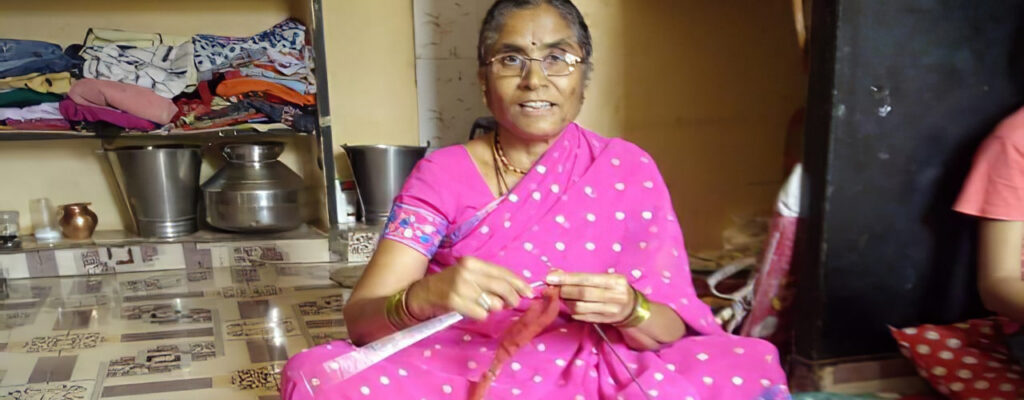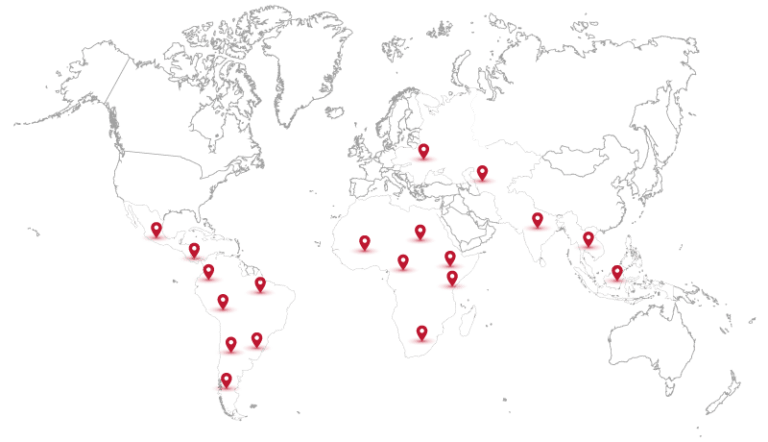Written by Jarina Shaikh and Jyoti Baiballi from LEARN, India.
How do our nations handle the millions of tonnes of fabric and garment waste generated every year? Often these garments and textiles go to the landfills or end up in the oceans; their materials and dyes cause pollution of soil, groundwater, seas and oceans along the way. How often does an old garment get a new life? Not too often. It is therefore grandmothers like Sumangal that need to be celebrated for their ecological recycling contribution to the planet, as they upcycle old garments into functional and beautiful products for everyday use.
Sumangal is a 55-year old widow. She wears two hats: one as a domestic worker and the other as a home-based worker. In the mornings, Sumangal goes to one household in an apartment complex nearby and makes perfectly round and yummy chapatis for her employer’s family. This brings in Rs. 600 per month. Too low for a skilled cook like Sumangal. But her age is a factor for her low pay as a domestic worker. After returning home from her job as a domestic worker, she has lunch and then weaves her magic bringing new life to old, discarded sarees.
Women in Sumangal’s community give their old sarees to repurpose them as floor mats. When Sumangal started this work, it was not common. She started to give her family, friends and community people free samples of her floor mats, and this zero-cost marketing strategy worked! After the first 30 women, Sumangal got her first customer 15 years ago. Self-employed women in the informal economy have to put in the extra effort of finding a market for their products, come up with creative marketing strategies, wait for long periods to earn their customers trust, and provide good quality work products to sustain that trust in the long run.
Usually, Sumangal goes to fetch sarees from the homes of willing customers. This is part of her service package—pick up and delivery is included in the cost of floor mats. All her commute is on foot, which can sometimes be up to 4 kms a day. After receiving an old saree from a client, Sumangal begins by cutting the saree into 2-inch-wide long strips. Her measurement tool? Her fingers. Despite the approximate nature of this measurement, the strips turn out evenly and look exactly the same. She then begins the intricate hand weaving and knotting process, joining one strip to another by putting a simple knot in their midst, until the entire saree is one long strip. Two long knitting needles are then used by her to weave a pattern through the long saree strip until it is transformed into a disc-shaped floor mat. Every day, Sumangal makes floor mats for approximately 3 hours, and it takes approximately 15 days to complete one piece perfectly. Each completed floor mat fetches her Rs. 60. The work is laborious, requires maintaining the sitting position continuously, also causes pain in her fingers, shoulders and back, and puts strain on her already compromised eyes. Her hard work and creativity means that she stops used garments and fabrics ending up in landfills or in the oceans, making her an ‘Eco-Warrior’. Let us also note that home-based work provides livelihood earning opportunities not only for senior citizens like Sumangal, but also to women in other vulnerable categories such as single mothers, differently-abled, HIV+, survivors of rape and other sexual assaults, acid attack survivors, historically marginalised communities such as Dalits and tribals— groups that are often excluded from employment and frequently discriminated against in the labour market. home-based work, however badly-paid, gives them an opportunity to earn a livelihood with self-respect and have a chance at being self-reliant. It is therefore even more pressing that the government gets involved in regulating wages in home-based work, not only for reasons of Decent Work, but also simultaneously supporting the employment/entrepreneurship of vulnerable from particularly marginalised sections.
Sumangal’s personal life is a gut-wrenching story. Living with her husband in a small village in Maharashtra’s Dhule district, Sumangal was happy with life on the farm. Her son had moved out and had started working in a telecommunications hardware manufacturing company in Nashik city, and her daughter too was married in the same city. After her husband’s untimely death, Sumangal was lonely and resourceless, without any support in the village. She decided to move in with her son in Nashik city, but this arrangement did not last long. After a few days of cordiality, she and her son could not get along. Her son treated her as a burden, frequently fighting, threatening and cussing. She put up with this behaviour, because she thought she had nowhere else to go. If she left, she would be immediately homeless. For a home-based worker, that means the end of their livelihood.
Meanwhile, her daughter started to have marital difficulties, which led to desertion by her husband. She was suddenly homeless and on her own, with a 6-month old baby to provide for. After the death of her first child soon after birth, she was determined not to let any ill circumstances impact the growth and life chances of her second child. It was at this moment, that she and her mother Sumangal decided to live together in a new house in the same community where Sumangal had developed a good customer base and rapport with the community. Seven years on, they are still living there together peacefully. Today, her daughter works in a company nearby assembling plastic goods, and is thankful for her mother’s support with childcare and domestic chores, as well as the financial contribution to the household. Sumangal’s grandson is a healthy 7-year old. He is growing up in a female-headed household with two strong female role models, who struggled for long years battling scars of time, approached hardship bravely, and emerged victorious.





